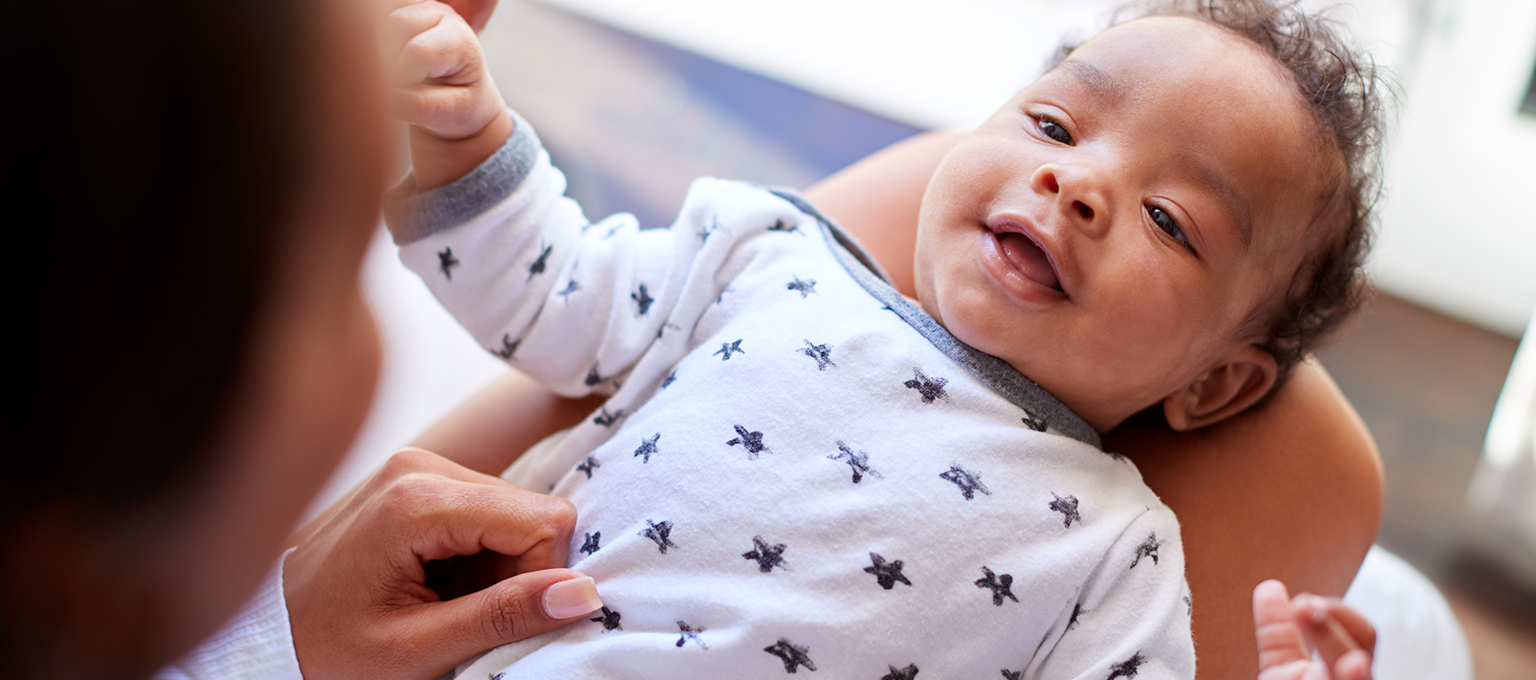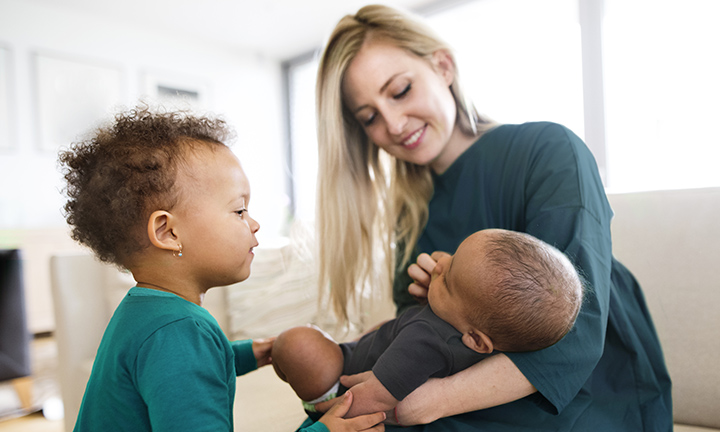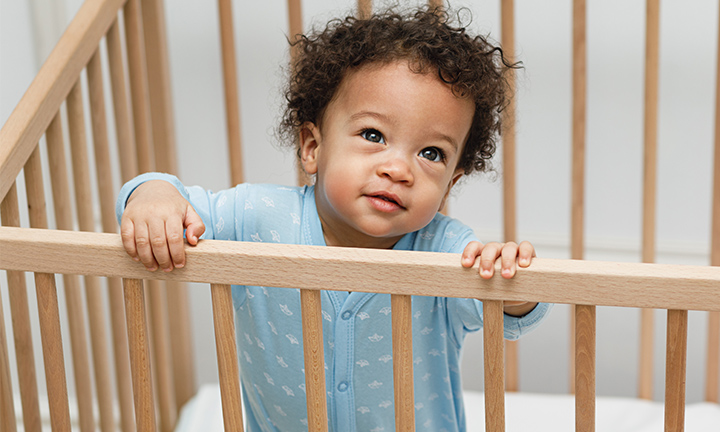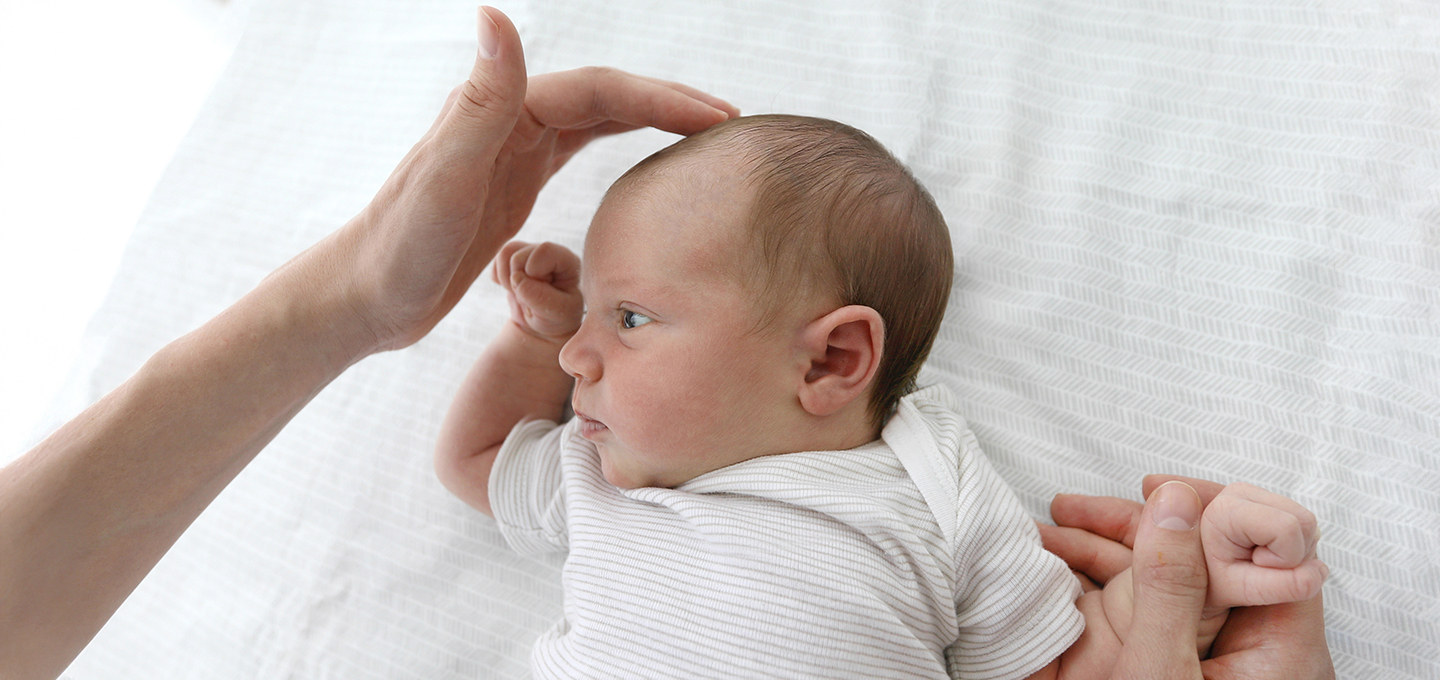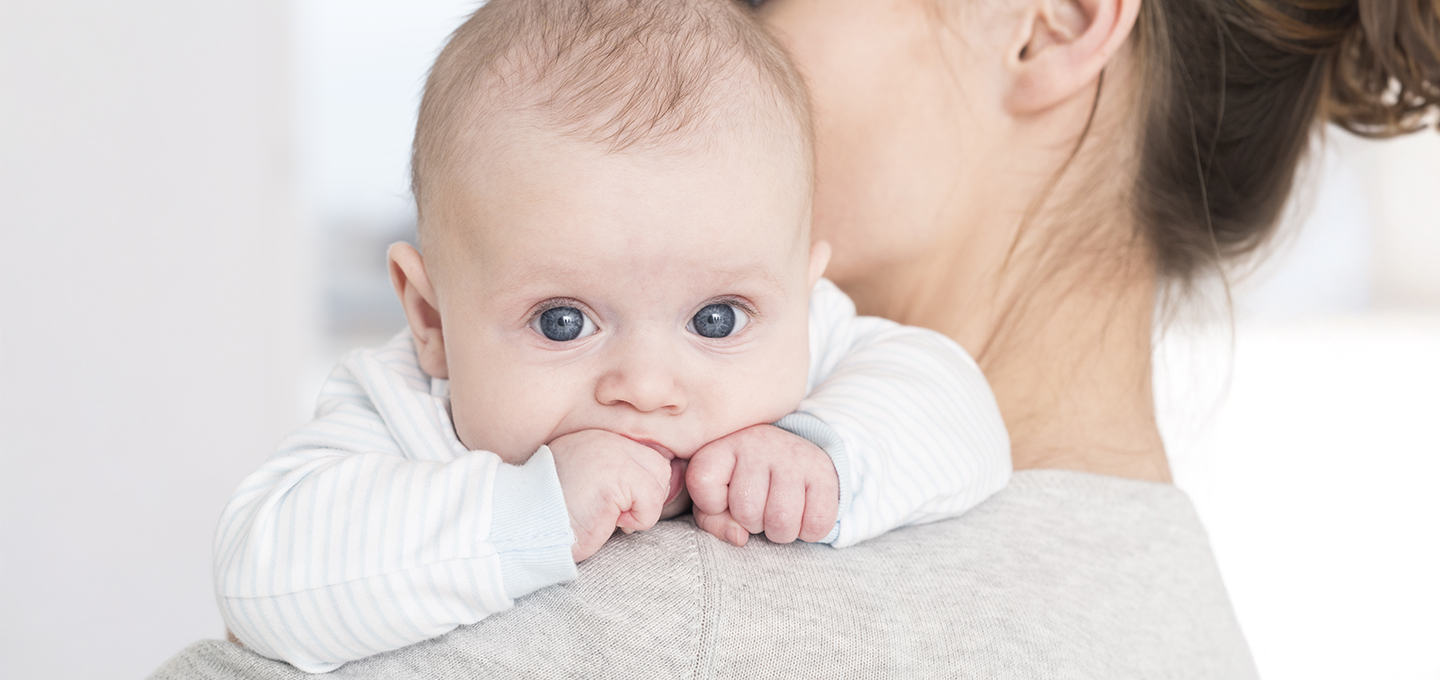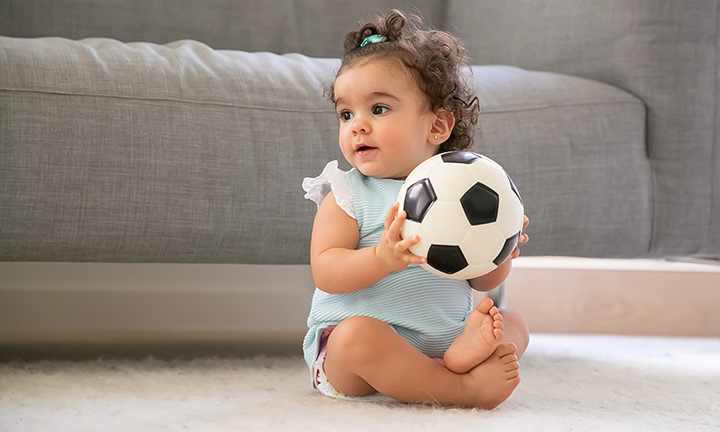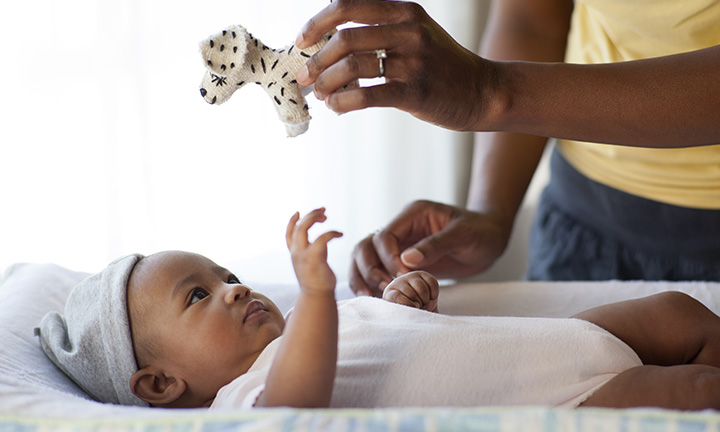
When, What, and How Far Can Newborns See?


At some point, after you’ve counted your newborn’s fingers and toes and stared lovingly into their eyes, you may wonder about your little one's visual development. When can newborns see? What can infants see? Can newborns see you or even the larger world around them? Read on to find out more about newborn baby eyesight, gain insight into your baby’s visual development in the coming months, and get some answers to your frequently asked questions.
When Can Newborns and Babies See?
Newborn babies can open their eyes and do, in fact, see when they are born. However, their eyesight is poor, and they can’t focus very well, especially on anything beyond 12 inches away. But this will soon change for your baby, who will be able to see more and more clearly in the coming months.
Babies who are born prematurely may have slightly different patterns of development. Preemies can be born with closed eyelids or even fused eyelids depending on how premature they are. If your preemie’s eyes are closed or fused at birth, their eyes will open within a short amount of time. Premature babies are also at risk for an eye disorder called retinopathy of prematurity.
Tip
When you’re doing skin-to-skin contact with your newborn, try to position your baby facing you so that they can see you easily. Faces are a favorite visual stimulus for babies.
When Do Babies Start Looking at You?
Your face is your baby’s favorite thing to look at. So, when can babies see faces? Newborn babies in general are drawn to look at their parents’ faces, especially the eyes, when they’re being held.
Eventually, between 1 and 3 months of age, they’ll be able to take in more of your face, not just your eyes. And they’ll be more responsive to facial expressions that may involve your mouth, jaw, or cheeks.
Tip
Newborns and older babies like to look at themselves in mirrors. Install a baby-safe mirror in your baby’s crib at their eye level and watch them enjoy looking at themselves.
How Far Can Newborns and Babies See?
Your baby’s distance vision develops gradually from birth onward. At birth, your newborn’s visual range is limited. Your little one can focus on something that's only about 8 to 12 inches from them—such as your face when you're holding them, or the corner of their crib. Within this range, they will examine things quite closely. Anything beyond 12 inches appears as a blurry shape—just as it would for an adult who wears glasses for distance vision.
Tip
The 8- to 12-inch range your little one can see at birth is about the distance between your face and your baby’s eyes when you’re holding or nursing them. Enjoy these special moments of bonding with your baby as you look at each other!
This limited range will gradually expand, and at about 3 months, your baby may start to notice you when you are halfway across the room—and maybe even smile at you! Your infant may also be able to gaze at an object lying just a few feet away, such as a toy.
By the time your baby is 4 months old, distance vision has progressed so much that they can stare out the window or look at something on the wall with interest, and by 7 months, their distance vision has improved greatly.
If your baby is around 4 months old, consider these stimulating play ideas.
What Can Newborns and Babies See?
So, what do infants see? At first, your baby may not be able to look at you or focus on your face, though they can perceive light and shape as well as detect movement. Before long, your newborn’s eyes will meet your eyes; this is more likely to occur in low light than in bright light, since their eyes are still very sensitive after leaving the darkness of the womb. You may also notice that your newborn’s eyes drift or even cross. This is normal and will decrease around 2 or 3 months when their eye muscles become stronger. If eye crossing persists beyond 3 months of age, speak with your baby’s healthcare provider.
The ability to see pattern and color develops at roughly the same rate for your baby. However, it will be easier for your little one to detect patterns before they start being able to distinguish between similar color hues. As development continues in your newborn baby's retinas—these are the light-sensitive tissues in the eyes—your little one will begin to see and recognize patterns, even by their first month. You may notice they will be drawn to simple black and white designs or those with strongly contrasting colors. At around 3 months old, they may be able to perceive if there is more than one object in a picture.
The higher the contrast in a pattern, the more appealing it is to your baby, who may prefer to gaze at black-and-white patterns such as checks and stripes (at around 1 month) and bull’s-eyes and spirals (by 3 months old).
When Do Newborns and Babies See Color?
Newborns, it turns out, see mostly in black and white, but it doesn't take long before babies are able to tell the difference between one color and another. At birth babies are sensitive to light (and don’t pick up on color differences), but by 2 weeks of age their pupils enlarge and they’re able to experience a wider range of dark and light shades of color.
So, how long do babies see only in black and white? At about 1 month, your little one can detect the brightness and intensity of colors, and over the next few months may start to see several basic colors, including red. Your baby's color vision is fully developed by about 4 months, when they'll be able to see lots of colors and even shades of colors.
Tip
So, what colors do babies see first? Try this: Hold three identical toys of different colors (blue, yellow, and red) in front of your baby. You may notice that your baby is more attracted to the red toy. Why? Experts aren’t entirely sure, but it could be either the color itself or its brightness.
For a little fun, put your parenting knowledge to the test with our fact or fiction quiz below:
When Can Babies Focus on Objects?
At birth, your baby lacks the ability to focus on things and track moving objects. No need to worry—these skills are developed over time.
Babies are born with peripheral vision, meaning they can see objects around them, at the sides of their visual field. But being able to focus closely on a specific object is something that develops over time. They gradually can focus on a single point in the center of their visual field. By 1 month old they’ll be able to briefly focus on objects as far as three feet away.
By 2 or 3 months of age your baby’s ability to focus may be developing steadily. Your baby may be able to turn both eyes inward, known as convergence, to focus on something nearby such as their hands. Simultaneously they will learn to turn both eyes outward, known as divergence, to focus on objects in the distance.
When Do Babies Start Tracking Objects with Their Eyes?
Another part of your infant’s visual development is tracking, or the ability to watch or follow a moving object with their eyes. Your baby will be able to track moving objects at around 3 or 4 months old. Here’s how it develops.
In the beginning, your newborn will struggle to watch a rattle when you shake it in front of their face, but in two months’ time, they will have better coordination and focus in both eyes, which will work together to follow the rattle’s movement.
Soon enough your infant will be able to track even smaller objects, like a length of yarn—and have a faster reaction to them. You may even notice during this time that your baby will look at your eyes to find out what you’re looking at—this is referred to as shared attention.
Tip
One way to help your baby practice following a moving object with their eyes is to move your head from side to side as your baby faces you. Or try moving a patterned toy or object up and down or side to side in front of your little one.
When your baby is about 3 months old, they will likely be able to use their arms and hands to swat at things in front of them (missing more often than not). Practicing this hand-eye coordination is great fun for them and for you too!
Depth perception starts to develop at about 5 months, after your baby has had some practice following objects coming toward them or away from them and can put together a three-dimensional view of the world.
Over time, as their motor skills improve, so will their aim and tracking ability.
Tip
Hang a mobile over your baby’s crib or place one in front of their bouncy seat to provide visual stimulation and encourage tracking. You’ll need to retire the mobile at around 5 months when babies are able to reach mobiles and try to pull them down, which can lead to entanglement.
Newborn and Baby Eye Development
So, when do infants develop full vision? Eyesight matures rapidly in young babies, and you'll be able to observe lots of progress as the weeks and months go by. Development will continue throughout the toddler and preschool years. At ages 3 to 5, a child with normal vision will be able to see as clearly as a typical adult, and by age 10, their visual system will be completely developed.
Among the early milestones you'll want to watch for are the following:
Newborn and Baby Visual Development
Take a look at our baby vision development chart below for a simple timeline of how your little one’s eyesight develops as they get older.
Your baby’s eyesight progresses from the moment they’re born, maturing rapidly throughout the first four months of life. Here are some key milestones to anticipate:
FAQS AT A GLANCE
From birth to 4 months, your baby’s eyesight is still developing. You can help by placing your face close to your baby during interactions, as they see best at close range. Offer high-contrast toys, like black and white patterns, to stimulate their visual development. Gently move objects from side to side to help them start tracking.
The Bottom Line
Your baby’s vision is just one of many areas of development your little one will experience. As the months go by, enjoy your baby's progress, and share the delight in their new abilities and achievements.
Learn more about typical growth and development for 4-month-old babies. If you have any questions or concerns about your baby’s eyesight, be sure to raise them with your baby's healthcare provider.
Are you curious about learning more about your child's development? In the Pampers Rewards app, you can follow along with your child's month-by-month development while also earning Pampers Cash for all the diapers you buy. Just scan the diaper code, most boxes have two, earn $10 Pampers Cash after 10 diaper scans, and redeem for $$ off Pampers at one of your favorite retailers.
- American College of Obstetricians and Gynecologists. Your Pregnancy and Childbirth: Month to Month, 7th ed. (Washington, DC: American College of Obstetricians and Gynecologists, 2021).
- Mayo Clinic. Guide to Your Baby’s First Years, 2nd ed. (Rochester, MN: Mayo Clinic Press, 2020).
- Healthy Children. Your Baby’s Vision – 1-month
- Kids Health. Your Newborn's Hearing, Vision, and Other Senses
- Kids Health. Your Baby's Hearing, Vision, and Other Senses: 1 Month


